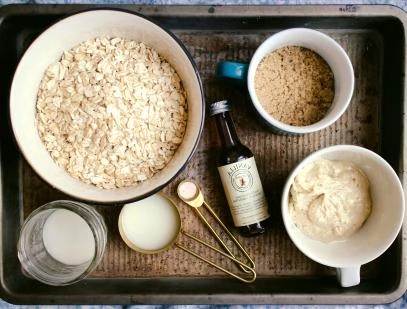If you crave dairy drinks but can’t because you’re a vegetarian or lactose intolerant, there are actually many plant-based milk options. For example, oat milk and almond milk are not only drinkable but can also be used in a variety of recipes.
How to Use Plant-Based Milks in Recipes
In most recipes, you can substitute plant-based milks with cow’s milk in a 1:1 ratio. However, be mindful of whether the plant-based milk you choose has added sugar, as the sugar content can affect the taste of the finished dish. Let’s learn about different plant-based milks and how they’re suitable for cooking.
Oat Milk
Oat milk is a common plant-based milk substitute for cow’s milk. It has a thick, smooth texture and rich flavor, making it ideal for simple dishes like mac and cheese gratin, or baked treats like whoopie pies. It can be used in both savory and sweet dishes, making it just as versatile as cow’s milk.
Almond Milk
Almond milk and oat milk have slightly different cooking uses. Almond milk isn’t suitable for savory dishes or desserts due to its slightly sweet flavor. However, it’s a great substitute for cow’s milk in recipes like American pancakes, pound cakes, muffins, biscuits, bread, and cookies. For example, use almond milk in the black sesame maple cookies (left) or the fluffy toast (right).
Also, if you’re replacing cow’s milk with almond milk in a baking recipe, you can use a 1:1 ratio, but because almond milk has a thinner texture, you’ll need to reduce the baking time.
If you’re using almond milk for a thicker pudding or custard filling, adding a little cornstarch or flour is recommended to thicken it.
Coconut Milk
There are actually two types of coconut milk to choose from, each with a different texture. The first type is thinner and liquid, like cow’s milk. It can often be found in the beverage section of supermarkets.
The second type is the thick coconut milk (also known as coconut cream) found in cans. Its consistency is roughly similar to condensed milk. While both types of coconut milk can be used in cooking, the texture of coconut milk you choose depends on the specific dish you’re preparing. If you’re making beverages like coconut milk coffee, use the first type, while if you’re preparing thicker dishes like curry or ice cream, use the second type.
Either type of coconut milk can impart a hint of coconut flavor to any dish or baked good.
Soy Milk
Soy milk is arguably the best milk substitute because its texture, protein content, and fat content are very similar to those of cow’s milk.
It’s perfect for both cooking and baking, and it’s also perfect for making custard (one of the most difficult ingredients to make without dairy milk). Simply swap the soy milk for the dairy milk in a 1:1 ratio.


Leave a Reply